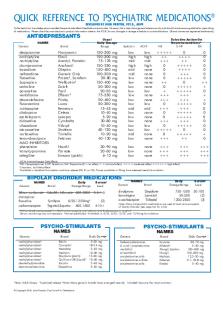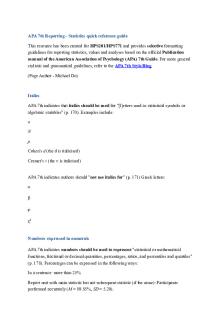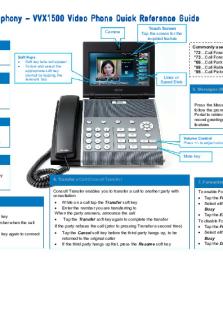BTS SIGN Asthma Guideline Quick Reference Guide 2019 PDF

| Title | BTS SIGN Asthma Guideline Quick Reference Guide 2019 |
|---|---|
| Course | Respiratory |
| Institution | University of York |
| Pages | 28 |
| File Size | 998.6 KB |
| File Type | |
| Total Downloads | 68 |
| Total Views | 150 |
Summary
BTS SIGN Asthma guidelines 2019...
Description
SIGN158 British guideline on the management of asthma
Quick reference guide First published 2003 Revised edition published July 2019
This Quick Reference Guide provides a summary of the main recommendations in SIGN 158 British guideline on the management of asthma. Recommendations are graded A B C D to indicate the strength of the supporting evidence. Good practice points are provided where the guideline development group wishes to highlight specific aspects of accepted clinical practice. Details of the evidence supporting these recommendations can be found in the full guideline, available on the SIGN website: www.sign.ac.uk. This Quick Reference Guide is also available as part of the SIGN Guidelines app.
978-1-909103-71-9 Scottish Intercollegiate Guidelines Network Gyle Square, 1 South Gyle Crescent Edinburgh EH12 9EB www.sign.ac.uk British Thoracic Society 17 Doughty Street London WC1N 2PL www.brit-thoracic.org.uk
SIGN and BTS consent to the photocopying of this guideline for the purpose of implementation in the NHS in England, Wales, Northern Ireland and Scotland.
Scottish Intercollegiate Guidelines Network British Thoracic Society
British guideline on the management of asthma
Quick reference guide First published 2003 Revised edition published July 2019
1
Diagnosis The diagnosis of asthma is a clinical one. The absence of consistent gold-standard diagnostic criteria means that it is not possible to make unequivocal evidence-based recommendations on how to make a diagnosis of asthma.
Definition and overarching concepts Central to all definitions is the presence of symptoms (more than one of wheeze, breathlessness, chest tightness, cough) and of variable airflow obstruction. •
There is no single diagnostic test for asthma
•
Diagnosis is based on clinical assessment supported by objective tests that seek to demonstrate variable airflow obstruction or the presence of airway inflammation
•
Both the clinical assessment of symptoms and signs, and objective tests have significant false positive and false negative rates
•
Tests influence the probability of asthma but do not prove a diagnosis
•
Asthma status and the outcome of diagnostic tests for asthma vary over time
C
Compare the results of diagnostic tests undertaken whilst a patient is asymptomatic with those undertaken when a patient is symptomatic to detect variation over time.
Practical approach to diagnosis The diagnosis of asthma in children and adults is based on the recognition of a characteristic pattern of respiratory symptoms, signs and test results and the absence of any alternative explanation for these.
2
Applies only to adults
Applies to children ≥1
Applies to children 5-12
Applies to children under 5
General
Applies to adolescents
Diagnosis Initial structured clinical assessment The predictive value of individual symptoms or signs is poor, and a structured clinical assessment including all information available from the history, examination and historical records should be undertaken. Factors to consider in an initial structured clinical assessment include: Episodic symptoms More than one of the symptoms of wheeze, breathlessness, chest tightness and cough occurring in episodes with periods of no (or minimal) symptoms between episodes. Note that this excludes cough as an isolated symptom in children. For example: •
a documented history of acute attacks of wheeze, triggered by viral infection or allergen exposure with symptomatic and objective improvement with time and/or treatment
•
recurrent intermittent episodes of symptoms triggered by allergen exposure as well as viral infections and exacerbated by exercise and cold air, and emotion or laughter in children
•
in adults, symptoms triggered by taking non-steroidal anti-inflammatory medication or beta blockers.
An historical record of significantly lower FEV₁ or PEF during symptomatic episodes compared with asymptomatic periods provides objective confirmation of the obstructive nature of the episodic symptoms. Wheeze confirmed by a healthcare professional on auscultation It is important to distinguish wheezing from other respiratory noises, such as stridor or rattly breathing. Repeatedly normal examination of chest when symptomatic reduces the probability of asthma. Evidence of diurnal variability Symptoms which are worse at night or in the early morning. Atopic history Personal history of an atopic disorder (ie eczema or allergic rhinitis) or a family history of asthma and/or atopic disorders, potentially corroborated by a previous record of raised allergen-specific IgE levels, positive skin-prick tests to aeroallergens or blood eosinophilia. Absence of symptoms, signs or clinical history to suggest alternative diagnoses (including but not limited to COPD, dysfunctional breathing, obesity).
Applies only to adults
Applies to children ≥1
Applies to children 5-12
Applies to children under 5
General
Applies to adolescents3
Diagnosis Assess probability of asthma based on initial structured clinical assessment High probability Adults and children with a typical clinical assessment including recurrent episodes of symptoms (attacks), wheeze heard by a healthcare professional, historical record of variable airflow obstruction and a positive history of atopy and without any features to suggest an alternative diagnosis have a high probability of asthma.
In patients with a high probability of asthma: • record the patient as likely to have asthma and commence a carefully monitored initiation of treatment (typically 6 weeks of inhaled corticosteroids) • assess the patient’s status with a validated symptom questionnaire ideally corroborated by lung function tests (FEV₁ at clinic visits or by domiciliary serial peak flows to capture times with/without symptoms) • with a good symptomatic and objective response to treatment, confirm the diagnosis of asthma and record the basis on which the diagnosis was made • if response is poor or equivocal, check inhaler technique and adherence, arrange further tests and consider alternative diagnoses.
Low probability Adults and children who do not have any of the typical features on initial structured clinical assessment or who have symptoms suggestive of an alternative diagnosis have a low probability of asthma.
• If there is a low probability of asthma and/or an alternative diagnosis is more likely, investigate for the alternative diagnosis reconsidering asthma if the clinical picture changes or an alternative diagnosis is not confirmed. • If reconsidering asthma, undertake or refer for further tests to investigate for a diagnosis of asthma.
Intermediate probability Adults and children who have some, but not all, of the typical features of asthma on an initial structured clinical assessment or who do not respond well to a monitored initiation of treatment have an intermediate probability of asthma D
Spirometry, with bronchodilator reversibility as appropriate, is the preferred initial test for investigating intermediate probability of asthma in adults, and in children old enough to produce reliable results on testing.
In adults and children with an intermediate probability of asthma and airways obstruction identified through spirometry, undertake reversibility tests and/or a monitored initiation of treatment assessing the response to treatment by repeating lung function tests and objective measures of asthma control.
In adults and children with an intermediate probability of asthma and normal spirometry results, undertake challenge tests and/or measurement of FeNO to identify eosinophilic inflammation.
In children with an intermediate probability of asthma who cannot perform spirometry: • consider watchful waiting if the child is asymptomatic • offer a carefully monitored trial of treatment if the child is symptomatic.
4
Applies only to adults
Applies to children ≥1
Applies to children 5-12
Applies to children under 5
General
Applies to adolescents
Diagnosis Diagnostic algorithm
Presentation with respiratory symptoms: wheeze, cough, breathlessness, chest tightness1 Structured clinical assessment (from history and examination of previous medical records) Look for: • recurrent episodes of symptoms • symptom variability • absence of symptoms of alternative diagnosis High probability of asthma
Assess response objectively (lung function/ validated symptom score)
Low probability of asthma
Intermediate probability of asthma Test for airway obstruction spirometry + bronchodilator reversibility
Code as: suspected asthma
Initiation of treatment
• recorded observation of wheeze • personal history of atopy • historical record of variable PEF or FEV1
Poor response
Other diagnosis unlikely
Options for investigations are: Test for variability: • reversibility • PEF charting • challenge tests
Good response
Test for eosinophilic inflammation or atopy: • FeNO • blood eosinophils, • skin-prick test, IgE
Investigate/treat for other more likely diagnosis
Asthma
Adjust maintenance dose
Good response
Provide selfmanagement advice Arrange on-going review 1
Suspected asthma: Watchful waiting (if asymptomatic) or Commence treatment and assess response objectively
Poor response
Other diagnosis confirmed
In children under 5 years and others unable to undertake spirometry in whom there is a high or intermediate probability of asthma, the options are monitored initiation of treatment or watchful waiting according to the assessed probabilityof asthma.
Applies only to adults
Applies to children ≥1
Applies to children 5-12
Applies to children under 5
General
Applies to adolescents5
Diagnosis Diagnostic indications for referral At any point in the diagnostic algorithm, there may be a need for referral for additional investigations and/or specialist advice. Some key indications for referral to specialist care are given below. Adults
Children
Refer for additional investigation and specialist advice if: Diagnosis unclear
Diagnosis unclear
Suspected occupational asthma (symptoms that improve when patient is not at work, adult-onset asthma and workers in high-risk occupations) Poor response to asthma treatment
Poor response to monitored initiation of asthma treatment
Severe/life-threatening asthma attack
Severe/life-threatening asthma attack
‘Red flags’ and indicators of other diagnoses Prominent systemic features (myalgia, fever, weight loss)
Failure to thrive
Unexpected clinical findings (eg crackles, clubbing, cyanosis, cardiac disease, monophonic wheeze or stridor)
Unexplained clinical findings (eg focal signs, abnormal voice or cry, dysphagia, inspiratory stridor)
Persistent non-variable breathlessness
Symptoms present from birth or perinatal lung problem
Chronic sputum production
Excessive vomiting or posseting
Unexplained restrictive spirometry
Severe upper respiratory tract infection
Chest X-ray shadowing
Persistent wet or productive cough
Marked blood eosinophilia
Family history of unusual chest disease Nasal polyps
Patient or parental anxiety or need for reassurance
Organisation of diagnostic services C
6
Streamlined referral pathways should be developed for tests which are not routinely available in primary care.
Applies only to adults
Applies to children ≥1
Applies to children 5-12
Applies to children under 5
General
Applies to adolescents
Monitoring Asthma is best monitored by routine clinical review on at least an annual basis by a healthcare professional with appropriate training in asthma management. The review can be undertaken in primary and/or secondary care according to clinical need and local service arrangements.
The core components of an asthma review that should be assessed and recorded on at least an annual basis are current symptoms, future risk of attacks, management strategies, supported self management, and growth in children.
Monitoring current asthma symptom control
When asking about asthma symptoms, use specific questions, such as the Royal College of Physicians ‘3 Questions’ or questions about reliever use, with positive responses prompting further assessment with a validated questionnaire to assess symptom control.
Whenever practicable, children should be asked about their own symptoms; do not rely solely on parental report.
Assessing risk of future asthma attacks It is possible to identify adults and children (aged 5 and over) with asthma who are at increased risk of an asthma attack and to stratify the degree of risk associated with different markers.
D
B
D
Assess risk of future asthma attacks at every asthma review by asking about history of previous attacks, objectively assessing current asthma control, and reviewing reliever use.
B
D
In children, regard comorbid atopic conditions, younger age, obesity, and exposure to environmental tobacco smoke as markers of increased risk of future asthma attacks.
D
Applies only to adults
In adults, regard older age, female gender, reduced lung function, obesity, smoking, and depression as markers of a slightly increased risk of future asthma attacks.
Applies to children ≥1
Applies to children 5-12
Applies to children under 5
General
Applies to adolescents7
Supported self management Asthma action plans Self-management education incorporating written personalised asthma action plans (PAAPs) improves health outcomes for people with asthma.
A
All people with asthma (and/or their parents or carers) should be offered self-management education which should include a written personalised asthma action plan and be supported by regular professional review.
A
In adults, written personalised asthma action plans may be based on symptoms and/or peak flows: symptom-based plans are generally preferable for children.
• A hospital admission represents a window of opportunity to review self-management skills. No patient should leave hospital without a written personalised asthma action plan. • An acute consultation offers the opportunity to determine what action the patient has already taken to deal with the asthma attack. Their self-management strategy may be reinforced or refined and the need for consolidation at a routine follow up considered. • A consultation for an upper respiratory tract infection or other known trigger is an opportunity to rehearse with the patient their self management in the event of their asthma deteriorating. • Education should include personalised discussion of issues such as trigger avoidance and occupational exposure to support people and their families living with asthma. • Every opportunity should be taken to remind patients and carers of the importance of achieving a smoke-free environment. • Brief simple education linked to patient goals is most likely to be acceptable to patients.
Self management in specific patient groups A
Self-management education, supported by a written personalised asthma action plan, should be offered to all patients on general practice ‘active asthma’ registers.
A
Primary care practices should ensure that they have trained professionals and an environment conducive to providing supported self management.
A
Prior to discharge, inpatients should receive written personalised asthma action plans, given by healthcare professionals with expertise in providing asthma education.
B
Culturally appropriate supported self-management education should be provided for people with asthma from ethnic minority groups. Addressing language barriers is insufficient.
Adherence and concordance D
Adherence to long-term asthma treatment should be routinely and regularly addressed by all healthcare professionals within the context of a comprehensive programme of accessible proactive asthma care.
D
To assess adherence, ask specific questions about medication use and assess prescribing and any other data available. Explore attitudes to medication as well as practical barriers to adherence in a non-judgemental way.
Implementation in practice B
8
Commissioners and providers of services for people with asthma should consider how they can develop an organisation which prioritises and actively supports self management. This should include strategies to proactively engage and empower patients and train and motivate professionals as well as providing an environment that promotes self management and monitors implementation.
Applies only to adults
Applies to children ≥1
Applies to children 5-12
Applies to children under 5
General
Applies to adolescents
Non-pharmacological management There is a common perception amongst patients and carers that there are numerous environmental, dietary and other triggers of asthma and that avoiding these triggers will improve asthma and reduce the requirement for pharmacotherapy. Evidence that non-pharmacological management is effective can be difficult to obtain and more well-controlled intervention studies are required.
Primary prevention Primary prevention relates to interventions introduced before the onset of disease and designed to reduce its incidence. A
Measures to reduce in utero or early life exposure to single aeroallergens, such as house dust mites or pets, or single food allergens, are not recommended for the primary prevention of asthma.
A
For children at risk of developing asthma, complex, multifaceted interventions targeting multiple allergens may be considered in families able to meet the costs, demands and inconvenience of such a demanding programme.
B
In the absence of any evidence of benefit and given the potential for adverse effects, maternal food allergen avoidance during pregnancy and lactation is not recommended as a strategy for preventing childhood asthma.
There is insufficient evidence to make a recommendation relating to the following as a strategy for preventing childhood asthma: •
maternal dietary supplementation during pregnancy
•
the use of dietary probiotics in pregnancy.
C
Breast feeding should be encouraged for its many benefits, including a potential protective effect in relation to early asthma.
C
Obese and overweight children should be offered weight-loss programmes to reduce the likel...
Similar Free PDFs

Oscola quick reference guide
- 1 Pages

296754820 BTS Installation Guideline
- 74 Pages

Oscola Quick Reference Guide DMU
- 3 Pages

BIWS LBO Quick Reference
- 18 Pages

Geometric Rules Quick Reference
- 7 Pages

Psychpharm Quick Reference
- 2 Pages

GDB Quick Reference (v4)
- 2 Pages
Popular Institutions
- Tinajero National High School - Annex
- Politeknik Caltex Riau
- Yokohama City University
- SGT University
- University of Al-Qadisiyah
- Divine Word College of Vigan
- Techniek College Rotterdam
- Universidade de Santiago
- Universiti Teknologi MARA Cawangan Johor Kampus Pasir Gudang
- Poltekkes Kemenkes Yogyakarta
- Baguio City National High School
- Colegio san marcos
- preparatoria uno
- Centro de Bachillerato Tecnológico Industrial y de Servicios No. 107
- Dalian Maritime University
- Quang Trung Secondary School
- Colegio Tecnológico en Informática
- Corporación Regional de Educación Superior
- Grupo CEDVA
- Dar Al Uloom University
- Centro de Estudios Preuniversitarios de la Universidad Nacional de Ingeniería
- 上智大学
- Aakash International School, Nuna Majara
- San Felipe Neri Catholic School
- Kang Chiao International School - New Taipei City
- Misamis Occidental National High School
- Institución Educativa Escuela Normal Juan Ladrilleros
- Kolehiyo ng Pantukan
- Batanes State College
- Instituto Continental
- Sekolah Menengah Kejuruan Kesehatan Kaltara (Tarakan)
- Colegio de La Inmaculada Concepcion - Cebu








